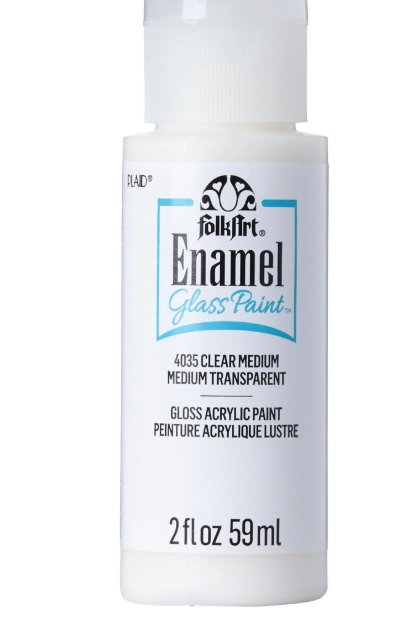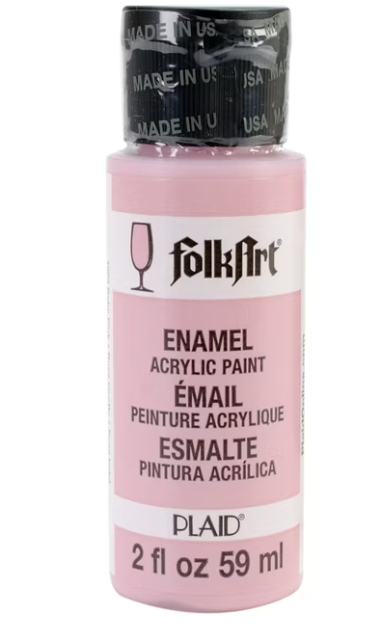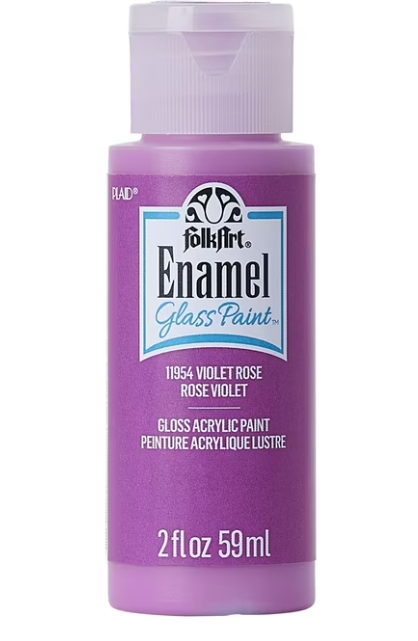
FolkArt Enamel Paint 2 fl oz, Clear Medium
- CONVENIENT SIZE – FolkArt Enamel Acrylic Paint comes in a convenient 2 oz size – perfect for creating one-of-a-kind handpainted glass projects!

FolkArt Enamel Paint 2oz-Baby Pink
- Artist approved
- Highly pigmented
- Superior scratch resistance
- Easy-to-use
- Non-Toxic

FolkArt Enamel Paint 2oz-Pure Orange
- Available in multiple colors
- 2 fl. oz. (59 ml)
- Water-based and non-toxic
- These Enamels are highly pigmented for opaque coverage with excellent hide and scratch resistance

FolkArt Enamel Paint 2oz-Violet Rose
- Brand New
- 028995119545
- Plaid:Craft
- 40-1954
Discover the Versatile Paint That Can Beautify Almost Any Surface
FolkArt Enamel Paint has become a favorite among crafters, DIYers, and artists for its rich color, excellent coverage, and versatility. This quick-drying, acrylic-based enamel paint can be used to enhance and colorize glass, wood, metal, ceramics, and more.
But like any art supply, there are essential things to know before purchasing FolkArt Enamel Paint for your projects. This complete buying guide will give you a deep dive into everything FolkArt Enamel – from what it is used for to how to apply and care for it. Read on to become an enamel paint expert!
What is FolkArt Enamel Paint Used For?
With its ability to adhere well and provide opaque coverage on both porous and non-porous surfaces, FolkArt Enamel Paint is extremely versatile for countless projects and crafts. Here are some of the top uses for this popular medium:
- Painting glassware – Jars, bottles, votives, and more can be transformed with FolkArt Enamel. It will provide vivid color and dries to a smooth, dishwasher-safe finish.
- Coating metal surfaces – FolkArt Enamel can be used to paint things like tin, aluminum, wrought iron, and other metals. It dries to a durable, chip-resistant finish.
- Customizing ceramic pieces – Transform plain terra cotta, bisque, glazed ceramics and more with FolkArt Enamel. It adheres very well to give ceramic pieces a makeover.
- Renovating wood decor – FolkArt Enamel can be applied to wood surfaces like crates, birdhouses, frames, and furniture to add pops of color.
- Creating jewelry – Enamel is often used in jewelry-making for coating metals like copper or brass. FolkArt Enamel allows crafters to add durable color to their pieces.
- Painting canvas – While best on hard, non-porous surfaces, FolkArt Enamel can work on canvas to achieve different effects with opacity and vibrancy.
- Adding design to candles – Coat the outside of plain pillars or votives with enamel paint to customize candles. Safe even when burned.
- Painting dishes and bakeware – FolkArt Enamel can transform old ceramic plates, mugs, and bakeware into fun, food-safe pieces.
How to Apply FolkArt Enamel Paint
Applying FolkArt Enamel Paint correctly is key to achieving the smooth, durable finish it’s known for. Follow these tips for best results:
- Prep the surface – Clean the surface and sand glossy items to help the paint adhere. Apply a primer coat if needed.
- Use proper brushes – Invest in quality nylon or synthetic brushes. Avoid using old brushes that may shed bristles.
- Apply thin coats – Thin layers of paint are better than thick. Allow paint to dry completely between coats.
- Cure when finished – Heat-set FolkArt Enamel after painting by baking or leaving in sun for a few days. This improves durability.
- Clean brushes promptly – After painting, clean brushes in warm, soapy water until the water runs clear. Let brushes dry flat.
Proper surface prep and following the manufacturer’s instructions for application and curing times will provide you with the best results using FolkArt Enamel Paint.
Where Can I Buy FolkArt Enamel Paint?
The good news is FolkArt Enamel Paint is readily available at most major craft retailers in the U.S. Here are some of the top places to buy it:
- Michael’s – This major craft store typically has the largest selection of FolkArt Enamel colors and quantities. They regularly run sales too.
- Joann Fabrics – Similar to Michael’s, Joann’s will have FolkArt Enamel in stock and available in high quantities.
- Hobby Lobby – FolkArt Enamel can be purchased at Hobby Lobby stores or online. They carry starter sets too.
- Walmart – Visit Walmart’s extensive craft section or shop online to buy FolkArt Enamel Paint.
- Amazon – Search Amazon for FolkArt Enamel in any color or quantity you need, with quick shipping.
- Blick Art Supplies – Blick is a leading art supplier that sells FolkArt Enamel Paint online or in select store locations.
- Local Craft Stores – Check with local independent craft stores to see if they stock this versatile paint.
The 2 fluid ounce bottles are the most common quantity sold. Prices range from $2.50-$5.00 depending on the outlet.
Is FolkArt Enamel Paint Waterproof?
One of the advantages of FolkArt Enamel Paint is that once fully cured, it forms a durable, water-resistant finish. The heat-set enamel paint will withstand cleaning and handwashing without losing its color or sheen.
However, it’s important to note that while FolkArt Enamel has excellent water resistance, it is not 100% impervious like an industrial grade epoxy paint. Prolonged submersion or soaking is not recommended. But for household use on glasses, mugs, serving trays and more, the enamel will hold up very well with regular use and washing.
Testing for curing before use and taking care not to soak items painted with FolkArt Enamel is the best way to utilize its water-resistant properties. It provides enough protection for everyday use.
How Long Does FolkArt Enamel Paint Take to Dry?
One great quality of FolkArt Enamel Paint is that it dries fairly quickly compared to other enamel paints. Here’s what to expect:
- Touch Dry: Approximately 30 minutes
- Handle Dry: About 1 hour
- Full Cure: Up to 7 days
The level of humidity and temperature will affect dry times. Warmer, drier environments will accelerate drying compared to cool, damp ones.
While FolkArt Enamel may feel dry to touch relatively fast, it’s important to wait the full cure time to heat set pieces painted with it. This allows the paint to become scratch- and chip-resistant.
Trying to bake or heat cure enamel paint before it has fully dried can cause bubbling or cracking of the painted surface. Patience creates the best results!
Can You Use FolkArt Enamel Paint on Glass?
Glass is one of the most popular surfaces for applying FolkArt Enamel Paint due to its smooth finish and vibrant colors. When properly prepped and cured, FolkArt Enamel bonds beautifully to glass surfaces.
Follow these tips for success painting glass with FolkArt Enamel:
- Wash the glass thoroughly with soap and water to remove any residue.
- Sand the glass lightly with fine sandpaper to rough up the glossy surface and help the paint adhere.
- Apply thin, even coats of enamel paint allowing drying time between coats.
- Once fully cured, heat set the enamel by placing glass in a warm oven (200°F) for 30 minutes or placing in direct sunlight for 7 days.
- After heat setting, wash gently by hand and avoid soaking to prevent chipping.
With proper prep and curing, FolkArt Enamel will provide a vibrant, durable finish on glassware. Items like glasses, vases, candle holders and more can be transformed!
Do You Need to Bake FolkArt Enamel Paint?
While FolkArt Enamel Paint will dry to the touch at room temperature, baking is recommended to fully cure the paint and maximize its durability. Baking helps it achieve an incredibly hard, scratch-resistant finish.
Here are some tips for properly baking FolkArt Enamel:
- Allow paint to dry for at least 24-48 hours before baking so all solvents can evaporate.
- Bake enamel paint at 200°F – 325°F for 30 minutes to 1 hour depending on the piece.
- Enameled pieces can also be placed outside in direct sunlight for up to 7 days to cure.
- Metal items may require higher baking temperatures – check manufacturer recommendations.
- Let all enameled pieces cool completely before handling after baking.
Baking may not be mandatory for decorative pieces not handled frequently. But for dishware or heavily used items, proper curing makes the enamel paint much more durable and long-lasting.
What Colors are Available in FolkArt Enamel Paint?
One of the best aspects of FolkArt Enamel Paint is the huge variety of colors available. Currently, there are 96 vibrant colors to choose from.
Their color palettes are separated into these categories:
- Opaque – Dense, opaque colors perfect for fully covering surfaces. Available in 74 colors like Lime Green, Pure Black, and Golden Yellow.
- Translucent – Sheer, jewel-toned colors that produce a stained glass effect. Available in 22 shades like Ruby Red and Emerald Green.
- Metallic – Five bold metallic finishes including Gold, Pewter, Bronze, Silver, and Pearlescent White.
- Fluorescent – Five neon shades like Electric Pink, Blazing Orange, and Radioactive Green that glow under black light.
There are finishes from bold primaries to soft pastels to please any enamel paint user. FolkArt also makes specialty collections like their Color Shift and Glitter Enamels for more options.
How to Remove FolkArt Enamel Paint from Surfaces?
While curable to a durable finish, FolkArt Enamel Paint can be removed from surfaces if needed. Here are some options:
- Soaking in hot, soapy water – Soak the painted piece to loosen the enamel then scrub gently with a plastic scrub brush or soft sponge.
- Rubbing alcohol – Use a lint-free cloth soaked in alcohol to rub the paint away. Reapply often.
- Acetone nail polish remover – Use 100% acetone remover on a cotton pad to gently wipe paint away.
- Scotch-Brite pad – Lightly scrub with an abrasive sponge to mechanically scrape enamel off.
- Sandpaper – For wood, metal, or glass, lightly sand paint away starting with 220 grit up to 400 grit.
- Paint remover gel – Chemical gels help lift enamel paint off surfaces but must be used cautiously.
Test removers in a small area first. Scrubbing too hard or using harsh chemicals can damage many surfaces underneath. Patience and proper solvents are key to safe enamel removal.
Is FolkArt Enamel Paint Safe for Dishes?
A common question is whether FolkArt Enamel can transform old glassware and dinnerware into food-safe painted dishes.
The answer is yes – when properly cured, FolkArt Enamel Paint is safe to use on ceramic plates, mugs, and other dishware.
The FDA-approved acrylic enamel paint is non-toxic and free from lead, cadmium, and other harmful chemicals. When heat cured onto glass and ceramic surfaces, FolkArt Enamel bonds securely and will not leach into food or drinks.
Hand-wash painted dishes gently after use and avoid soaking them in water. While not impervious, FolkArt Enamel holds up wonderfully to regular use and washing when applied correctly to dishes and glassware.
What Surfaces Can You Use FolkArt Enamel Paint On?
From metals to ceramic tile, FolkArt Enamel Paint adheres well to a wide variety of surfaces, including:
- Glass – Drinking glasses, vases, mirrors, candles holders, etc.
- Wood – Painted furniture, wood signs, crates, frames, terra cotta pots, etc.
- Metal – Tin, aluminum, wrought iron, antique silver, copper, etc.
- Ceramics – Glazed ceramics, bisque ware, terra cotta pots, ceramic tiles, etc.
- Canvas & paper – For painted texture and opacity (not as durable)
- Wicker & straw – Baskets, mats, hats, and natural fibers
- Clay & polymer clay – Can be baked onto cured clay and porcelain
- Fabrics – On fabrics coated with a fixative first
- Concrete & plaster – Colorize statuary, garden pieces, plaster figurines, etc.
Proper prep like sanding, priming, and curing will allow FolkArt Enamel Paint to bond to almost any surface imaginable. It ́s versatility makes it a crafter ́s dream!
How to Cure FolkArt Enamel Paint?
Curing is an important process with enamel paints like FolkArt to help them reach maximum durability, hardness, and water resistance. Here are ways to cure painted pieces:
- Oven Bake – Bake at 200°F – 325°F for 30 min – 1 hour once completely dry. Best for glass and ceramics.
- Sun Cure – Place items in direct sunlight for up to 1 week to cure paint.
- Air Dry – Allow paint to cure at room temp for up to 1 month before use. Least durable method.
- Heat Gun – Use a heat gun to gently cure paint in sections immediately after applying.
- Dehydrator – A food dehydrator can be used at the lowest setting to gradually cure enameled pieces.
- Microwave – Only for small ceramic and glass items. Heat at 10 second intervals checking between each one.
Take care not to over-cure enamel paint which can lead to bubbling, cracking, or discoloration. FolkArt offers great versatility in how pieces can be properly cured for maximum durability.
Does FolkArt Enamel Paint Need a Primer?
In most cases, FolkArt Enamel will adhere well directly to surfaces without needing a separate primer coat. The exception is on porous materials like wood or ceramics where a primer creates a smoother base.
Here are good primers to use with FolkArt Enamel:
- FolkArt Enamel Undercoater – A primer made specifically for FolkArt Enamel Paint provides excellent adhesion.
- Gesso – For priming wood and canvas to provide a textured, absorbent base.
- Adhesion promoters – Sold for glass and metal, these help the paint cling.
- Spray paint primers – Choose enamel compatible options for priming in spray form.
For plastics, wax-based finishes, laminates, or metals prone to rust, adhesion promoters and primers are recommended. Otherwise FolkArt Enamel Paint itself serves as a sufficient primer in most cases.
Can FolkArt Enamel Paint Be Used Outdoors?
While best suited for indoor crafts and home décor, FolkArt Enamel Paint can be used successfully outdoors as well when properly sealed. Here are some tips:
- Cure the enamel paint fully before using outside. Sun-cure items for up to 1 week.
- Use an exterior grade sealer like polyurethane over the cured enamel paint. This prevents UV damage and water penetration.
- For outdoor furniture or signs, applying multiple coats (at least 3) provides greater protection.
- Expect to repaint or touch up outdoor pieces more often than indoor.
- Avoid placing outdoor enameled pieces in direct rain or snow. An awning provides better protection.
With ample curing time, sealing, and touch-ups as needed, FolkArt Enamel can add beautiful color to outdoor planters, signs, metal art, and furniture.
How to Clean Brushes After Using FolkArt Enamel Paint?
FolkArt Enamel Paint cleans up best when tackled while still wet. Follow these steps for cleaning brushes:
- Swirl brushes in a jar of warm, soapy water to remove residual paint.
- Keep swirling and rinsing until water runs clear and no more paint comes out.
- Gently massage the bristles of the damp brush using your fingers to finish removing any hidden paint.
- Rinse once more in clean water.
- Press water out of the bristles and shape them before letting the brush fully dry.
- For dried on enamel paint, soak the brush in an enamel paint thinner to loosen and then wash as normal.
Proper brush care maintains the integrity of the bristles for achieving smooth FolkArt Enamel finishes over and over again.
Is FolkArt Enamel Paint Non-Toxic?
This is an important question for anyone painting items used for food or by children.
Fortunately, FolkArt Enamel Paint is certified non-toxic once fully cured. It is free from lead, cadmium, and other toxic pigments. The FDA compliant acrylic paint is suitable for use on dinnerware when properly baked on.
That said, enamels should always be used cautiously:
- Work in a well-ventilated area and allow pieces to fully dry before use.
- Keep out of reach from children and pets while wet.
- Avoid ingesting paint or paint fumes.
Once cured, FolkArt Enamel paint presents no toxicity hazards making it safe for a wide range of decorative uses. It dries to an inert, non-reactive finish.
Can You Mix FolkArt Enamel Paint Colors?
The versatile acrylic formula of FolkArt Enamel Paint allows colors to be mixed together easily. This is great for custom colors. However:
- Only mix opaque colors together. The translucent colors can become muddled when mixed.
- Shades of similar tones combine more seamlessly than drastically different hues.
- Add just a drop or two of the secondary color into the base color. A little goes a long way.
- A palette knife or old brush is best for mixing so as not to contaminate your main paint colors.
- Test your mixed shade on a paint sample board before committing it to your project.
Follow the above tips, and you can easily achieve new custom colors from the FolkArt Enamel Paint palette.
How to Achieve a Smooth Finish with FolkArt Enamel Paint?
The high-gloss, glass-like finish of cured FolkArt Enamel Paint is part of its appeal. Follow these tips for the smoothest results:
- Carefully follow the manufacturer ́s instructions for surface prep and application.
- Apply paint in multiple thin, even coats rather than thick layers. Thick paint is prone to drips and texturing.
- Allow adequate drying time between coats – at least 24 hours.
- Sand lightly with fine sandpaper between coats for the smoothest finish.
- Always heat cure the paint either in an oven or by sun curing once fully dry.
- Remove any dust or debris between coats. Work in a clean, low-dust space.
- Maintain a wet edge as you paint and avoid going over areas as they begin to dry.
A smooth FolkArt Enamel finish requires patience but yields gorgeous results worth the effort!
Does FolkArt Enamel Paint Chip Easily?
When applied to non-porous surfaces like glass or metal, cured FolkArt Enamel Paint provides a strongly bonded finish. However, it can still chip if subjected to heavy use or abrasion over time.
Here are some tips to minimize chipping:
- Allow paint to cure fully either in the oven or with a 7 day sunlight cure before use.
- Always hand wash rather than scrub enameled pieces. Avoid metal scrubbers.
- Apply at least 3 thin coats of enamel paint for greater protection on frequently handled items.
- Seal outdoor pieces with polyurethane for added protection from weather.
- Spot touch up any worn spots or stressed corners as soon as possible.
- Consider a clear top coat like polyacrylic for extra durability on tableware.
Enamel paints will never offer the same unbreakable durability as fired glass glazes. But curable enamel paints like FolkArt do provide very good chip resistance with proper care.
How to Store FolkArt Enamel Paint Properly?
To keep FolkArt Enamel Paint in optimal condition for years, follow these storage tips:
- Store paint at room temperature away from extreme cold or heat.
- Keep cans tightly sealed to prevent the paint drying out.
- Clean the rim and threads of the can before replacing the lid after use.
- For partial cans of paint, squeeze air out and store with the lid upside down to create a tight seal.
- Don ́t let paint freeze as it can damage the emulsion. Store paint above 55°F.
- Store paint out of direct sunlight to prevent fading or drying.
- Leftover mixed custom colors should be stored in a separate jar, not the original can.
Follow the manufacturer’s guidelines for storage and dispose of old, unusable paint properly. With proper care kept in a cool, dark place, FolkArt Enamel Paint can remain usable for years.
In Summary
From versatile uses to proper application and care, FolkArt Enamel Paint provides crafters and DIYers with vibrant, durable results on almost any surface imaginable. Just be sure to follow techniques for curing, prep, and storage to get the most out of this classic enamel paint.
Ready to try your hand at glass painting, give a metal chair a makeover, or customize dishware with color? Get stocked up on the essentia FolkArt Enamel Paint colors – and enjoy unleashing your creativity!






